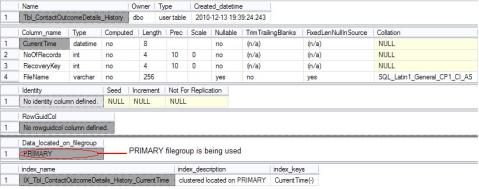We can move the tables which have Clustered Indexes to another filegroups very easily. And if you want to move a table that does not have any Clustered Indexes then please create one on the table and then move ( ideally we should have Clustered Indexes on every table for performance gains).
Lets first check the properties of the table that has Clustered Indexes:
I am showing this blog with ‘[dbo].[Tbl_ContactOutcomeDetails_History]‘ table in one of my sample database.
sp_help ‘[dbo].[Tbl_ContactOutcomeDetails_History]‘As
As you can see that currently the table is on PRIMARY filegroup. Now we will Move this table to SECONDARY filegroup. We will use the Clustered Index called “IX_Tbl_ContactOutcomeDetails_History_CurrentTime” to move this table to SECONDARY filegroup.
This is the following syntax to move the table along with its Clustered Index to SECONDARY filegroup:
USE [AdventureWorks]
GO
CREATE CLUSTERED INDEX [IX_Tbl_ContactOutcomeDetails_History_CurrentTime] ON [dbo].[Tbl_ContactOutcomeDetails_History]
(
[CurrentTime] DESC
)WITH (PAD_INDEX = OFF, STATISTICS_NORECOMPUTE = OFF, SORT_IN_TEMPDB = OFF, IGNORE_DUP_KEY = OFF, DROP_EXISTING = ON, ONLINE = OFF, ALLOW_ROW_LOCKS = ON, ALLOW_PAGE_LOCKS = ON) ON [Secondary]
GO
After this query is successfully executed, let’s check the properties of the Table again:
sp_help ‘[dbo].[Tbl_ContactOutcomeDetails_History]‘
So you can see that we have moved the table from PRIMARY filegroup to SECONDARY filegroup with single command which was not too difficult.
Lets first check the properties of the table that has Clustered Indexes:
I am showing this blog with ‘[dbo].[Tbl_ContactOutcomeDetails_History]‘ table in one of my sample database.
sp_help ‘[dbo].[Tbl_ContactOutcomeDetails_History]‘As
This is the following syntax to move the table along with its Clustered Index to SECONDARY filegroup:
USE [AdventureWorks]
GO
CREATE CLUSTERED INDEX [IX_Tbl_ContactOutcomeDetails_History_CurrentTime] ON [dbo].[Tbl_ContactOutcomeDetails_History]
(
[CurrentTime] DESC
)WITH (PAD_INDEX = OFF, STATISTICS_NORECOMPUTE = OFF, SORT_IN_TEMPDB = OFF, IGNORE_DUP_KEY = OFF, DROP_EXISTING = ON, ONLINE = OFF, ALLOW_ROW_LOCKS = ON, ALLOW_PAGE_LOCKS = ON) ON [Secondary]
GO
After this query is successfully executed, let’s check the properties of the Table again:
sp_help ‘[dbo].[Tbl_ContactOutcomeDetails_History]‘


No comments:
Post a Comment